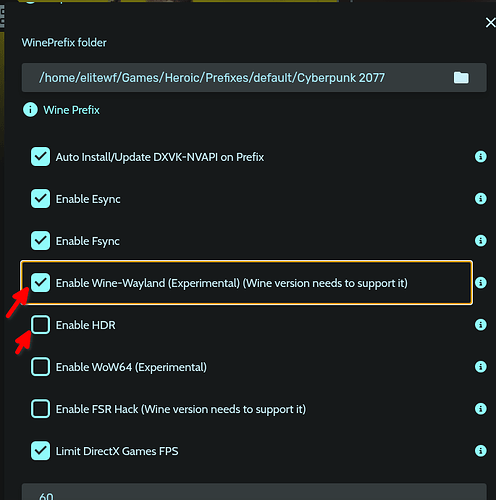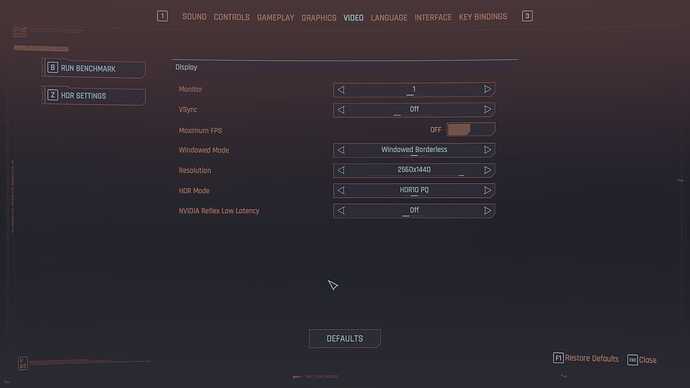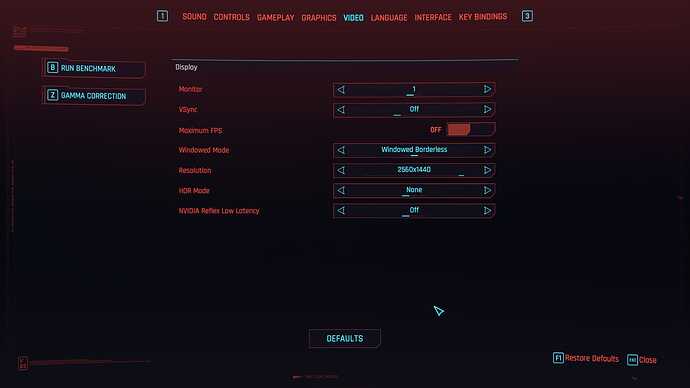Good Evening! Hope you’re all having a wonderful day!
Here’s hoping I’m not crazy or crazy unlucky, because I’ve seen this issue sporadically in other forums but everyone reports it as already solved since nvidia 650 driver ver.
My issue is as follows: for some reason, when enabling hdr in my hdr-capable screen (main monitor, have a second one which can’t use hdr) the colors seem washed out. I’m on kde wayland, so the first thing that came to mind is using the calibration tools offered by kde, but they only affect brightness. the color saturation is already at 100, and cannot go higher.
For whatever reason, any time I want to play a game with hdr enabled (proton-ge-custom, proton_enable_wayland=1 and proton_hdr_enabled=1, of course) the colors become washed out, to the point of looking bleached. no in-game configuration can resolve the issue. I also noticed some things (such as the steam client) having worse colors too, but since it’s from x-server I guess that problem could be anything else.
as required, here’s my garuda inxi, I hope one of you has the answer to this madness, or at least some pointers. Right now not even arch’s wiki page can give me a hand.
System:
Kernel: 6.16.8-zen3-1-zen arch: x86_64 bits: 64 compiler: gcc v: 15.2.1
clocksource: tsc avail: hpet,acpi_pm
parameters: BOOT_IMAGE=/@/boot/vmlinuz-linux-zen
root=UUID=9a5d2ff6-aac6-44da-bdad-b83a4b541903 rw rootflags=subvol=@
quiet loglevel=3 splash
Desktop: KDE Plasma v: 6.4.5 tk: Qt v: N/A info: frameworks v: 6.18.0
wm: kwin_wayland with: krunner tools: avail: hypridle,hyprlock vt: 1
dm: SDDM Distro: Garuda base: Arch Linux
Machine:
Type: Desktop System: ASUS product: N/A v: N/A serial: <superuser required>
Mobo: ASUSTeK model: TUF GAMING X870-PLUS WIFI v: Rev 1.xx
serial: <superuser required> part-nu: SKU uuid: <superuser required>
UEFI: American Megatrends v: 0237 date: 07/22/2024
Battery:
Device-1: ps-controller-battery-8c:41:f2:0c:05:f0 model: N/A serial: N/A
charge: N/A status: discharging
CPU:
Info: model: AMD Ryzen 9 7950X bits: 64 type: MT MCP arch: Zen 4 gen: 4
level: v4 note: check built: 2022+ process: TSMC n5 (5nm) family: 0x19 (25)
model-id: 0x61 (97) stepping: 2 microcode: 0xA601206
Topology: cpus: 1x dies: 2 clusters: 2x1 cores: 16 threads: 32 tpc: 2
smt: enabled cache: L1: 1024 KiB desc: d-16x32 KiB; i-16x32 KiB L2: 16 MiB
desc: 16x1024 KiB L3: 64 MiB desc: 2x32 MiB
Speed (MHz): avg: 4761 min/max: 425/5883 boost: enabled scaling:
driver: amd-pstate-epp governor: powersave cores: 1: 4761 2: 4761 3: 4761
4: 4761 5: 4761 6: 4761 7: 4761 8: 4761 9: 4761 10: 4761 11: 4761 12: 4761
13: 4761 14: 4761 15: 4761 16: 4761 17: 4761 18: 4761 19: 4761 20: 4761
21: 4761 22: 4761 23: 4761 24: 4761 25: 4761 26: 4761 27: 4761 28: 4761
29: 4761 30: 4761 31: 4761 32: 4761 bogomips: 287440
Flags-basic: avx avx2 ht lm nx pae sse sse2 sse3 sse4_1 sse4_2 sse4a
ssse3 svm
Vulnerabilities: <filter>
Graphics:
Device-1: NVIDIA GA102 [GeForce RTX 3090] vendor: Gigabyte driver: nvidia
v: 580.82.09 alternate: nouveau,nvidia_drm non-free: 550-580.xx+
status: current (as of 2025-08; EOL~2026-12-xx) arch: Ampere code: GAxxx
process: TSMC n7 (7nm) built: 2020-2023 pcie: gen: 2 speed: 5 GT/s
lanes: 16 link-max: gen: 4 speed: 16 GT/s ports: active: DP-3 empty: DP-1,
DP-2, HDMI-A-1, HDMI-A-2 bus-ID: 01:00.0 chip-ID: 10de:2204 class-ID: 0300
Device-2: Advanced Micro Devices [AMD/ATI] Raphael vendor: ASUSTeK
driver: amdgpu v: kernel arch: RDNA-2 code: Navi-2x process: TSMC n7 (7nm)
built: 2020-22 pcie: gen: 4 speed: 16 GT/s lanes: 16 ports:
active: HDMI-A-3 empty: DP-4,DP-5,Writeback-1 bus-ID: 73:00.0
chip-ID: 1002:164e class-ID: 0300 temp: 50.0 C
Display: wayland server: X.org v: 1.21.1.18 with: Xwayland v: 24.1.8
compositor: kwin_wayland driver: X: loaded: amdgpu,nvidia
unloaded: modesetting,nouveau alternate: fbdev,nv,vesa dri: radeonsi
gpu: amdgpu,nv_platform,nvidia,nvidia-nvswitch d-rect: 4480x2520
display-ID: 0
Monitor-1: DP-3 pos: primary,top-left model: ViewSonic VX3218C-QHD
serial: <filter> built: 2024 res: mode: 2560x1440 hz: 120 scale: 100% (1)
dpi: 93 gamma: 1.2 size: 697x392mm (27.44x15.43") diag: 800mm (31.5")
ratio: 16:9 modes: max: 2560x1440 min: 640x480
Monitor-2: HDMI-A-3 pos: bottom-r model: Samsung C27F390 serial: <filter>
built: 2015 res: mode: 1920x1080 hz: 72 scale: 100% (1) dpi: 82 gamma: 1.2
size: 598x336mm (23.54x13.23") diag: 686mm (27") ratio: 16:9 modes:
max: 1920x1080 min: 720x400
API: EGL v: 1.5 hw: drv: nvidia drv: amd radeonsi platforms: device: 0
drv: nvidia device: 1 drv: radeonsi device: 3 drv: swrast gbm:
drv: kms_swrast surfaceless: drv: nvidia wayland: drv: nvidia x11:
drv: nvidia inactive: device-2
API: OpenGL v: 4.6.0 compat-v: 4.5 vendor: nvidia mesa v: 580.82.09
glx-v: 1.4 direct-render: yes renderer: NVIDIA GeForce RTX 3090/PCIe/SSE2
memory: 23.44 GiB display-ID: :1.0
API: Vulkan v: 1.4.321 layers: 17 device: 0 type: discrete-gpu
name: NVIDIA GeForce RTX 3090 driver: nvidia v: 580.82.09
device-ID: 10de:2204 surfaces: N/A device: 1 type: integrated-gpu name: AMD
Radeon Graphics (RADV RAPHAEL_MENDOCINO) driver: mesa radv
v: 25.2.3-arch1.2 device-ID: 1002:164e surfaces: N/A device: 2 type: cpu
name: llvmpipe (LLVM 20.1.8 256 bits) driver: mesa llvmpipe
v: 25.2.3-arch1.2 (LLVM 20.1.8) device-ID: 10005:0000 surfaces: N/A
Info: Tools: api: clinfo, eglinfo, glxinfo, vulkaninfo
de: kscreen-console,kscreen-doctor gpu: corectrl, nvidia-settings,
nvidia-smi wl: wayland-info x11: xdpyinfo, xprop, xrandr
Audio:
Device-1: NVIDIA GA102 High Definition Audio vendor: Gigabyte
driver: snd_hda_intel v: kernel pcie: gen: 4 speed: 16 GT/s lanes: 16
bus-ID: 01:00.1 chip-ID: 10de:1aef class-ID: 0403
Device-2: Advanced Micro Devices [AMD/ATI] Radeon High Definition Audio
[Rembrandt/Strix] vendor: ASUSTeK driver: snd_hda_intel v: kernel pcie:
gen: 4 speed: 16 GT/s lanes: 16 bus-ID: 73:00.1 chip-ID: 1002:1640
class-ID: 0403
Device-3: Advanced Micro Devices [AMD] Family 17h/19h/1ah HD Audio
vendor: ASUSTeK driver: snd_hda_intel v: kernel pcie: gen: 4 speed: 16 GT/s
lanes: 16 bus-ID: 73:00.6 chip-ID: 1022:15e3 class-ID: 0403
API: ALSA v: k6.16.8-zen3-1-zen status: kernel-api with: aoss
type: oss-emulator tools: N/A
Server-1: PipeWire v: 1.4.8 status: active with: 1: pipewire-pulse
status: active 2: wireplumber status: active 3: pipewire-alsa type: plugin
4: pw-jack type: plugin tools: pactl,pw-cat,pw-cli,wpctl
Network:
Device-1: Realtek RTL8125 2.5GbE vendor: ASUSTeK driver: r8169 v: kernel
pcie: gen: 2 speed: 5 GT/s lanes: 1 port: e000 bus-ID: 06:00.0
chip-ID: 10ec:8125 class-ID: 0200
IF: eno1 state: up speed: 1000 Mbps duplex: full mac: <filter>
Device-2: MEDIATEK vendor: AzureWave driver: mt7925e v: kernel pcie:
gen: 2 speed: 5 GT/s lanes: 1 port: N/A bus-ID: 07:00.0 chip-ID: 14c3:7925
class-ID: 0280
IF: wlp7s0 state: down mac: <filter>
IF-ID-1: virbr0 state: down mac: <filter>
Info: services: NetworkManager, smbd, systemd-timesyncd
Bluetooth:
Device-1: IMC Networks Wireless_Device driver: btusb v: 0.8 type: USB
rev: 2.1 speed: 480 Mb/s lanes: 1 mode: 2.0 bus-ID: 1-11:6
chip-ID: 13d3:3602 class-ID: e001 serial: <filter>
Report: btmgmt ID: hci0 rfk-id: 0 state: up address: <filter> bt-v: 5.4
lmp-v: 13 status: discoverable: no pairing: no class-ID: 7c0104
Drives:
Local Storage: total: 5.88 TiB used: 2.66 TiB (45.3%)
SMART Message: Unable to run smartctl. Root privileges required.
ID-1: /dev/nvme0n1 maj-min: 259:1 vendor: Smart Modular Tech.
model: SHPP41-2000GM size: 1.82 TiB block-size: physical: 512 B
logical: 512 B speed: 63.2 Gb/s lanes: 4 tech: SSD serial: <filter>
fw-rev: 51060A20 temp: 55.9 C scheme: GPT
ID-2: /dev/nvme1n1 maj-min: 259:0 vendor: Smart Modular Tech.
model: SHPP41-2000GM size: 1.82 TiB block-size: physical: 512 B
logical: 512 B speed: 63.2 Gb/s lanes: 4 tech: SSD serial: <filter>
fw-rev: 51060A20 temp: 52.9 C scheme: GPT
ID-3: /dev/sda maj-min: 8:0 vendor: Kingston model: SA400S37480G
size: 447.13 GiB block-size: physical: 512 B logical: 512 B speed: 6.0 Gb/s
tech: SSD serial: <filter> fw-rev: J4.3 scheme: GPT
ID-4: /dev/sdb maj-min: 8:16 vendor: Kingston model: SA400S37480G
size: 447.13 GiB block-size: physical: 512 B logical: 512 B speed: 6.0 Gb/s
tech: SSD serial: <filter> fw-rev: 66B5 scheme: GPT
ID-5: /dev/sdc maj-min: 8:32 vendor: Samsung model: HD154UI size: 1.36 TiB
block-size: physical: 512 B logical: 512 B type: USB rev: 3.0 spd: 5 Gb/s
lanes: 1 mode: 3.2 gen-1x1 tech: N/A serial: <filter> fw-rev: 0404
scheme: MBR
Partition:
ID-1: / raw-size: 446.83 GiB size: 446.83 GiB (100.00%)
used: 332.14 GiB (74.3%) fs: btrfs dev: /dev/sdb2 maj-min: 8:18
ID-2: /boot/efi raw-size: 300 MiB size: 299.4 MiB (99.80%)
used: 636 KiB (0.2%) fs: vfat dev: /dev/sdb1 maj-min: 8:17
ID-3: /home raw-size: 446.83 GiB size: 446.83 GiB (100.00%)
used: 332.14 GiB (74.3%) fs: btrfs dev: /dev/sdb2 maj-min: 8:18
ID-4: /var/log raw-size: 446.83 GiB size: 446.83 GiB (100.00%)
used: 332.14 GiB (74.3%) fs: btrfs dev: /dev/sdb2 maj-min: 8:18
ID-5: /var/tmp raw-size: 446.83 GiB size: 446.83 GiB (100.00%)
used: 332.14 GiB (74.3%) fs: btrfs dev: /dev/sdb2 maj-min: 8:18
Swap:
Kernel: swappiness: 133 (default 60) cache-pressure: 100 (default) zswap: no
ID-1: swap-1 type: zram size: 61.92 GiB used: 5.9 MiB (0.0%) priority: 100
comp: zstd avail: lzo-rle,lzo,lz4,lz4hc,deflate,842 dev: /dev/zram0
Sensors:
System Temperatures: cpu: 57.5 C mobo: N/A gpu: amdgpu temp: 51.0 C
Fan Speeds (rpm): N/A
Info:
Memory: total: 64 GiB available: 61.92 GiB used: 9.6 GiB (15.5%)
Processes: 668 Power: uptime: 4h 0m states: freeze,mem,disk suspend: deep
avail: s2idle wakeups: 0 hibernate: platform avail: shutdown, reboot,
suspend, test_resume image: 24.65 GiB services: org_kde_powerdevil,
power-profiles-daemon, upowerd Init: systemd v: 258 default: graphical
tool: systemctl
Packages: 2943 pm: pacman pkgs: 2918 libs: 624 tools: gnome-software,
octopi, pacseek, paru, yay pm: flatpak pkgs: 25 Compilers: clang: 20.1.8
gcc: 15.2.1 alt: 14 Shell: Bash v: 5.3.3 default: fish v: 4.1.1
running-in: konsole inxi: 3.3.39
Garuda (2.11.0-1):
System install date: 2024-03-15
Garuda release: 231029
Last full system update: 2025-10-01
Is partially upgraded: No
Relevant software: snapper NetworkManager dracut nvidia-utils nvidia-open-dkms garuda-hardware-profile-nvidia garuda-hardware-profile-standard garuda-hardware-profile-standard-x11
Windows dual boot: Probably (Run as root to verify)
Failed units:
--- System Health Check Report ---
23/24 checks run in 1.04 seconds ⌛
Powered by garuda-health 🦅
✅ System health check passed. No issues found.
Hope you have a lovely day!


